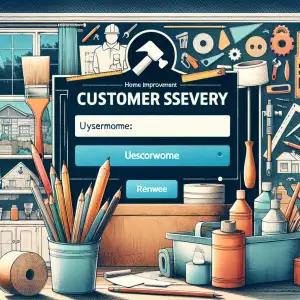Lowe's Reports Strong Second Quarter Earnings

Lowe's Overview
Lowe's is a well-known home improvement retail giant, catering to both DIY enthusiasts and professional contractors. With a vast network of stores across the United States and Canada, Lowe's offers an extensive inventory of products for home construction, renovation, maintenance, and decor. From appliances and tools to lumber and paint, customers can find everything they need to tackle projects of all sizes. Lowe's is committed to providing a seamless shopping experience, both in-store and online. Their website features detailed product information, helpful DIY guides, and convenient online ordering options. Beyond its product offerings, Lowe's is dedicated to community engagement and sustainability. The company actively supports various charitable organizations and initiatives focused on housing, disaster relief, and community development. Lowe's also prioritizes environmental responsibility by implementing sustainable practices throughout its operations, from sourcing products to reducing waste.
History and Founding
Lowe's, the retail giant we know today for all things home improvement, has surprisingly humble beginnings. The first store, far from the sprawling warehouse format we're familiar with, was a small-town hardware store in North Wilkesboro, North Carolina. It was 1946, the end of World War II had just ushered in a wave of homebuilding, and businessman H. Carl Buchan saw an opportunity. He partnered with his brother-in-law, James Lowe, a veteran who had experience in the lumber industry. Together, they laid the foundation for what would become a household name.
Initially, Lowe's catered to a rural customer base, offering everything from overalls and snuff to building materials. As the business grew, so did its focus on home improvement. James Lowe bought out Buchan's share in 1952, taking sole ownership and steering the company towards its future identity. The post-war housing boom fueled Lowe's expansion, and by 1960, the year James Lowe passed away, the company had grown to seventeen stores.
While Lowe himself didn't live to see the company's massive expansion, his legacy of hard work and customer focus laid the groundwork for Lowe's to become a true retail powerhouse. His commitment to value and offering a wide selection of products resonated with customers and set the stage for Lowe's to become a household name synonymous with home improvement.
Business Model
Lowe's operates primarily as a retail business. They offer a vast inventory of home improvement products, ranging from appliances and tools to building materials and décor. This merchandise caters to both DIY homeowners and professional contractors. The company generates revenue through direct sales, both in-store and online.
Beyond product sales, Lowe's drives revenue through various services. These include installation services for products like flooring and appliances, facilitating a smoother customer experience and generating additional income. They've also tapped into the contractor market by offering credit accounts and bulk discounts, fostering loyalty within this valuable customer segment.
Lowe's emphasizes its private label brands alongside well-known national brands. This dual approach allows them to capture various price points and customer preferences. Their private label strategy contributes to higher profit margins compared to national brands.
The company leverages its extensive network of physical stores as strategic assets. These locations serve as showrooms for customers to experience products firsthand and as fulfillment centers for online orders. This omnichannel approach maximizes convenience and caters to evolving shopping preferences.
Product Categories and Services
Lowe's is your one-stop shop for all your home improvement needs, offering an extensive selection of products and services across numerous categories.
Whether you're tackling a small project or a complete renovation, Lowe's provides everything from appliances, such as refrigerators, washing machines, and ovens, to tools and hardware, including power tools, hand tools, fasteners, and more.
Transform your living spaces with their wide variety of flooring options, including hardwood, laminate, tile, and carpet, or create your dream bathroom with their selection of vanities, toilets, showers, and bathtubs.
Lowe's also offers a wide array of outdoor living products, such as patio furniture, grills, lawnmowers, and gardening supplies, allowing you to create your perfect outdoor oasis.
In addition to their extensive product selection, Lowe's provides a range of services to assist you with your home improvement projects. Their knowledgeable staff can offer expert advice and guidance, while their installation services cover everything from flooring and countertops to windows and appliances.
With their commitment to quality, affordability, and customer satisfaction, Lowe's is your trusted partner for all your home improvement needs.
Target Market
Lowe's primary target market is homeowners and renters engaged in do-it-yourself (DIY) and home improvement projects. This encompasses a broad range of individuals, from first-time homeowners tackling small renovations to experienced DIY enthusiasts undertaking large-scale projects. Lowe's caters to both male and female customers, recognizing the significant role women play in home improvement decisions.
While the core target market includes DIYers, Lowe's also targets professional contractors and tradespeople by offering professional-grade tools, materials, and services tailored to their specific needs. This segment benefits from bulk pricing, dedicated account managers, and specialized product knowledge.
Geographically, Lowe's primarily targets customers in suburban and rural areas where homeownership rates are higher. Their stores are strategically located in these areas, often near other home-related retailers, to provide convenience and accessibility. Lowe's also recognizes the growing trend of urban living and has expanded its offerings to cater to apartment dwellers and city residents undertaking smaller-scale projects.
Key Competitors
Lowe's faces stiff competition in the home improvement retail market. Its primary competitor is Home Depot, the largest home improvement retailer in the United States. Home Depot's vast inventory, competitive pricing, and strong brand recognition make it a formidable rival. Another significant competitor is Menards, a Midwest-based chain known for its low prices and unique product offerings. Menards' focus on value and customer service has earned it a loyal customer base.
Beyond these major players, Lowe's also contends with competition from online retailers such as Amazon. Amazon's vast selection, competitive pricing, and convenience pose a challenge to traditional brick-and-mortar retailers like Lowe's. Additionally, specialty retailers like Ace Hardware and True Value, with their focus on niche markets and personalized service, also compete with Lowe's for customers seeking specialized products or expert advice. The home improvement retail landscape is constantly evolving, with new competitors and business models emerging. To stay ahead, Lowe's must continue to innovate, adapt to changing consumer preferences, and differentiate itself from the competition.
Financial Performance
Lowe's, a Fortune 500 company, has demonstrated a consistent track record of financial strength and profitability. As a leading retailer in the home improvement sector, Lowe's has benefited from a large customer base and strong brand recognition. The company's revenue has grown steadily in recent years, driven by both organic growth and strategic acquisitions. Lowe's has also maintained a healthy profit margin, reflecting its operational efficiency and effective pricing strategies.
Furthermore, Lowe's has a strong balance sheet with low debt levels, providing it with financial flexibility for future investments and expansion. The company generates significant cash flow from its operations, enabling it to reinvest in its business, pursue strategic acquisitions, and return value to shareholders through dividends and share repurchases. Lowe's commitment to financial discipline has earned it a favorable credit rating from major agencies, further solidifying its financial stability.
E-commerce and Digital Strategy
Lowe's has fully embraced the digital age, understanding that today's home improvement journey often begins online. Their e-commerce platform is robust and user-friendly, offering a vast inventory that mirrors their physical stores. Customers can browse, compare products, read reviews, and even access how-to guides and project inspiration. Lowe's has invested heavily in creating a seamless online and in-store experience. Their "omni-channel" approach allows customers to buy online and pick up in-store, often within hours. This is particularly appealing to DIYers and contractors needing materials quickly. They've also integrated their loyalty program, Lowe's Advantage Club, into their digital strategy, allowing customers to earn rewards and access exclusive deals online and in-store.
Lowe's leverages technology to enhance the customer experience further. Their mobile app provides real-time inventory checks, allowing customers to see if a product is in stock at their local store before making the trip. The app also features an image search function, where customers can snap a picture of a product or project and find matching items or inspiration on Lowe's website. Lowe's understands the power of social media in today's digital landscape. They actively engage with customers on platforms like Instagram, Facebook, and Pinterest, offering design ideas, DIY tips, and showcasing their products in real-life settings.
Sustainability Initiatives
Lowe's recognizes the importance of environmental and social responsibility and is committed to making a positive impact. The company focuses its sustainability efforts on three key areas: reducing its environmental footprint, nurturing a better world, and building sustainable products. Lowe's has set ambitious goals to reduce its carbon emissions and water consumption. The company is investing in energy-efficient technologies in its stores and distribution centers and partnering with suppliers to source sustainably harvested wood and other materials. Lowe's is dedicated to supporting communities and disaster relief efforts. The company partners with organizations like Habitat for Humanity and the American Red Cross to provide affordable housing and disaster relief assistance. Lowe's also supports programs that promote skilled trades education and training. Lowe's offers a wide selection of sustainable products to help customers make environmentally friendly choices. These products meet rigorous standards for energy efficiency, water conservation, and indoor air quality. Lowe's sustainability initiatives reflect the company's commitment to creating a better future for its customers, employees, and the planet.
Community Involvement
Lowe's believes in being a part of the communities we serve. We show this commitment by supporting local organizations and initiatives that make a difference. Our stores across the country regularly partner with nonprofits, schools, and community groups to provide essential resources, funding, and volunteer hours. We focus on initiatives that promote safe and affordable housing, skilled trades education, and disaster relief efforts. Our Team Lowe's volunteer force, made up of our dedicated associates, is actively involved in projects like building homes with Habitat for Humanity, revitalizing parks and playgrounds, and assisting communities impacted by natural disasters. We believe that by working together, we can create a lasting positive impact on our neighborhoods and help build a better future for all.
Future Outlook and Challenges
Lowe's faces a dynamic landscape in the home improvement sector. E-commerce giants like Amazon continue to disrupt traditional retail models, challenging Lowe's to enhance its online presence and offer a seamless omnichannel experience. Competition from other big-box retailers, notably Home Depot, remains fierce, requiring Lowe's to differentiate itself through competitive pricing, product selection, and customer service. The company must also navigate economic fluctuations, as housing market trends and consumer spending directly impact home improvement projects. Attracting and retaining skilled labor is crucial for Lowe's to maintain its in-store experience and installation services. Furthermore, Lowe's needs to adapt to evolving consumer preferences, particularly among millennials and Gen Z, who often prioritize online shopping, sustainable products, and personalized experiences. By addressing these challenges head-on and leveraging its strengths, Lowe's can position itself for continued growth and success in the ever-evolving home improvement market.
``` ```htmlLowe's faces a dynamic landscape in the home improvement sector. E-commerce giants like Amazon continue to disrupt traditional retail models, challenging Lowe's to enhance its online presence and offer a seamless omnichannel experience. Competition from other big-box retailers, notably Home Depot, remains fierce, requiring Lowe's to differentiate itself through competitive pricing, product selection, and customer service. The company must also navigate economic fluctuations, as housing market trends and consumer spending directly impact home improvement projects. Attracting and retaining skilled labor is crucial for Lowe's to maintain its in-store experience and installation services. Furthermore, Lowe's needs to adapt to evolving consumer preferences, particularly among millennials and Gen Z, who often prioritize online shopping, sustainable products, and personalized experiences. By addressing these challenges head-on and leveraging its strengths, Lowe's can position itself for continued growth and success in the ever-evolving home improvement market.
Publikováno: 23. 06. 2024
Kategorie: Business



